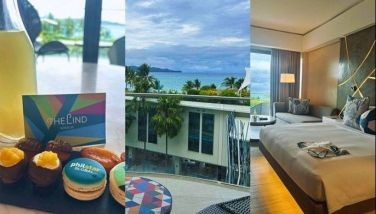‘Changing Phl skyline and consumers’ lifestyle’

The proliferation of huge malls in Metro Manila and rapid expansion in the provinces can be deemed both as a spur and a response to rapid urbanization. Similarly, these can both be an impetus and a response to the growing demand for domestic and foreign consumer products.
Is this trend good or bad for the economy and the Filipino people?
(Almost half of the population now live in urban areas, according to the Housing and Urban Development Coordinating Council, and that proportion will reach 56.6% in 2030 and 60% in 2050.)
Property developer Manny Villar and Socioeconomic Planning Secretary Arsenio Balisacan both attribute the rapid urbanization and the demand for upscale residences and consumer goods to the over 10 million overseas Filipino workers, who have been remitting billions in foreign exchange ($24.3 billion in 2014). Villar says a “large part” of that (in peso equivalent) goes to OFW families in the provinces. Balisacan estimates that $7 billion of such remittances go into property investments.
The combined families of OFWs and the over one million employees of business process outsourcing (BPO) outfits, he notes, are providing “an expanding market for retailers and malls.”
Moreover, “malls and other real-estate projects [such as townships -- self-contained districts consisting of residences, offices, schools, shops, and parks] “are changing the skyline in many areas, as well as the lifestyle of Filipino consumers,” Villar adds.
In many instances, however, these property-development projects have taken over farmlands and poor communities, displacing increasing numbers of peasant and other impoverished families.
By Villar’s reckoning, there are now 153 malls, mostly in Metro Manila. And more are being built by the following big property developers:
• Henry Sy’s SM Prime Holdings has 52 malls, with three more to be completed by end-2015. All together, the 55 malls will occupy 8.27 million square meters of retail space. The biggest among these are the Mall of Asia (200,000 sqm, expanding to 550,000 sqm) and SM City Seaside in Cebu (472,400 sqm). For this year alone, SM has set aside P66-billion capital expenditure for malls and other projects.
• John Gokongwei’s Robinsons Land Corp. has 44 malls and is adding five more in the provinces in 2015 and 2016. Its capital allotment for this year is P17 billion.
• Ayala Land Inc. owns 16 malls and plans to open eight more in 2015 and 2016.
(In Forbes’ list of the 10 richest Filipino billionaires for 2015, Sy is No. 1, with $14.4 billion net worth; Gokongwei, No. 2 with $5.5 billion; and Jaime Zobel de Ayala, No. 8 with $3.5 billion.)
• Starmall Inc. (owned by Villar, net worth: $1.5 B) has six malls with 400,000-sqm retail space; it plans to expand this to one million sqm on a P26-billion budget. This year it will add three malls, another five in 2016, costing P1.5 billion to P2 billion each.
Besides the above, two other property developers are coming into the picture: Edgar Sia II’s Double Dragon Properties and Lucio Co’s (net worth: $1.7 B) Cosco Capital.
• Double Dragon’s target is to build 25 malls this year and up to 100 malls by 2020, according to real estate adviser Saville World Research.
• Cosco Capital plans to build eight malls in the next two years, after having acquired five commercial properties and nine supermarkets, which are placed under its Puregold brand.
Last week, I wrote about how the big property developers have ventured into the retailing business outside the malls by entering into partnerships with big retailers, domestic and foreign, inducing the influx of more foreign-brand goods competing with local products. Here’s more on that:
• While Robinsons Retail Holdings Inc. pursues a P6-billion plan to build 300 of its own Mini-Stop convenience stores and mini-supermarkets, it has ventured into franchising another foreign coffee brand: British Costa Coffee. Having opened its first outlet in Eastwood, it eyes a second one in Bonifacio Global City. “We plan to open 70 stores in five years,” said Robina Gokongwei-Pe, RRHI president.
• Cosco Capital’s Puregold has partnered with the Japanese convenience-store chain, Lawson Inc., to roll out 500 Lawson outlets in the country by 2020.
• Ayala Land and Puregold have formed a 50-50% joint venture, called AyaGold Retailers Inc. to operate a new grocery chain under a local brand: Merkado Supermarket. The first outlet has opened at Ayala’s UP Town Center. AyaGold plans to open eight to 10 stores by 2020, mostly in Metro Manila, spending P200 million per outlet
What looks good about this joint venture is that the next Merkado stores will all be outside Ayala malls and will offer an extensive line of merchandise – with only 5% to be imported, they say – plus its own bakery and rotisserie.
AyaGold’s prioritizing of domestic products is a departure from Ayala’s thrust in its joint venture with Rustan’s Group and Japanese conglomerate Itochu: to roll out 100 outlets of Itochu’s convenience-store brand FamilyMart. Similarly, as mentioned above, Ayala’s partner Puregold is in its own tieup which will promote Japanese product lines via 500 Lawson stores.
In batting for the construction of malls and other shopping centers in the provinces, Villar argues that this not only opens up new markets for the retail business. “This prevents the saturation of the Metro Manila market,” he avers, “while stimulating economic activities in other parts of the country.”
The latter point – stimulating economic activities in the provinces – can be truly beneficial to the economy and the rural population if it’s consciously focused on encouraging and improving the output of locally produced consumer goods, both agricultural and non-agricultural, to supply the big retailers.
* * *
Email: satur.ocampo@gmail.com.
- Latest
- Trending































